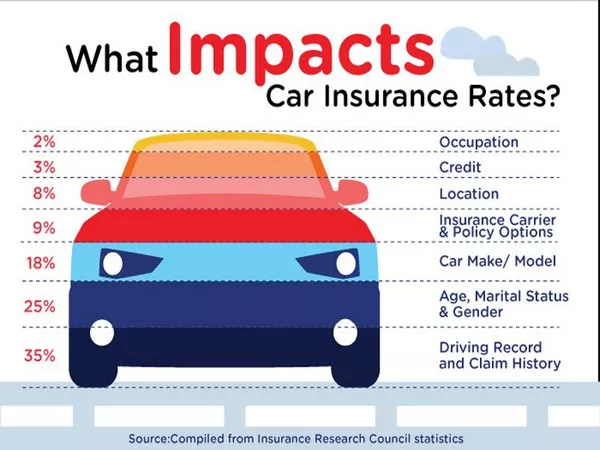Car insurance is essential for protecting yourself, your vehicle, and others on the road. However, financial difficulties can make it challenging to afford premiums. This raises a critical question: What if you can’t afford car insurance? In this comprehensive guide, we will explore the implications of being uninsured, options available for those facing financial hardships, and practical strategies for ensuring that you remain compliant with state laws while safeguarding your financial future.
Understanding the Importance of Car Insurance
Why Car Insurance Matters
Car insurance serves multiple purposes:
Legal Requirement: Most states mandate a minimum level of insurance coverage to legally operate a vehicle.
Financial Protection: It protects against significant financial loss in the event of accidents, theft, or damage.
Liability Coverage: It covers damages you may cause to others, shielding you from potential lawsuits.
Consequences of Being Uninsured
Driving without insurance can lead to severe consequences:
Legal Penalties: Fines, license suspension, or even jail time in some jurisdictions.
Financial Liability: If you cause an accident, you may be held responsible for all damages, leading to substantial out-of-pocket costs.
Increased Future Premiums: Being caught driving uninsured can lead to higher insurance premiums in the future.
Assessing Your Financial Situation
1. Budget Analysis
If you’re struggling to afford car insurance, start by analyzing your budget:
Income vs. Expenses: Identify all your monthly income sources and expenses to determine how much you can allocate for insurance.
Essential vs. Non-Essential Costs: Distinguish between essential expenses (like rent and food) and non-essential ones (like dining out or subscriptions).
2. Identifying Areas to Cut Back
To make room for insurance costs, consider reducing expenses:
Reduce Discretionary Spending: Cut back on non-essential purchases.
Negotiate Bills: Contact service providers to negotiate lower rates on utilities or internet services.
Options for Affordable Car Insurance
1. State Programs and Assistance
Many states offer programs designed to help low-income individuals obtain car insurance:
Low-Income Auto Insurance Programs: Some states provide subsidized insurance plans specifically for low-income drivers.
State-Sponsored Insurance Pools: These pools offer coverage for drivers who have difficulty obtaining insurance due to high-risk factors.
2. Shop Around for Rates
Insurance premiums can vary significantly between providers. Take the time to:
Compare Quotes: Use online tools to compare quotes from multiple insurers.
Ask About Discounts: Inquire about discounts for safe driving, low mileage, or bundling policies.
See also: What Happens If Accident Damage Exceeds Your Car Insurance?
3. Consider High-Deductible Policies
A high-deductible policy can lower your monthly premium:
How It Works: You agree to pay a higher amount out-of-pocket in the event of a claim, which can significantly reduce your premium.
Risk Assessment: Make sure you can afford the deductible if you need to make a claim.
4. Adjust Coverage Levels
Evaluate your coverage needs:
Review Your Policy: If you have an older vehicle, consider dropping collision and comprehensive coverage to save money.
State Minimum Coverage: Ensure you have at least the minimum coverage required by your state.
Alternative Transportation Options
If car insurance remains unaffordable, consider alternative transportation methods:
1. Public Transportation
Utilizing public transit can be a cost-effective solution:
Costs vs. Savings: Compare the cost of public transit fares with your current insurance and fuel costs.
Convenience: Many cities offer reliable public transportation systems that can effectively meet your commuting needs.
2. Carpooling and Ridesharing
Explore options for shared transportation:
Carpooling: Share rides with colleagues or friends to reduce costs and expenses.
Rideshare Services: Use services like Uber or Lyft for occasional transportation without the burden of car ownership.
3. Biking and Walking
For shorter distances, consider:
Biking: An eco-friendly and economical alternative for commuting.
Walking: If feasible, walking can save costs and improve your health.
Finding Financial Assistance
1. Nonprofit Organizations
Some nonprofit organizations offer assistance for low-income individuals:
Community Assistance Programs: Research local organizations that may provide financial aid for essential services, including insurance.
Grants and Scholarships: Look for grants aimed at helping low-income families maintain essential expenses.
2. Payment Plans and Financing Options
Many insurers offer flexible payment options:
Installment Payments: Ask if your insurance provider offers the option to pay premiums in installments instead of a lump sum.
Third-Party Financing: Some companies provide financing for insurance premiums, allowing you to spread the cost over time.
Legal Considerations
1. Understanding State Laws
Every state has different laws regarding car insurance:
Minimum Coverage Requirements: Familiarize yourself with the minimum requirements in your state to avoid legal issues.
Penalties for Uninsured Driving: Understand the potential penalties you may face if caught driving without insurance.
2. Seeking Legal Advice
If you are facing financial hardship and legal troubles related to insurance, consider consulting a legal professional:
Consultations: Many lawyers offer free consultations to discuss your situation and options.
Legal Aid Services: Look for local legal aid organizations that can provide assistance at little to no cost.
Building a Long-Term Strategy
1. Improving Your Financial Health
Focus on strategies to enhance your overall financial situation:
Increase Income: Consider part-time work or gig economy opportunities to supplement your income.
Skill Development: Invest in education or training to improve job prospects and earning potential.
2. Planning for Future Insurance Needs
To avoid future insurance issues, consider the following:
Emergency Fund: Build a savings cushion specifically for unexpected expenses, including insurance premiums.
Regular Policy Review: Reassess your insurance coverage regularly to ensure it meets your needs and budget.
Conclusion
Navigating the challenges of affording car insurance can be daunting, but it is essential for your legal compliance and financial protection. If you find yourself unable to afford coverage, numerous options exist to help you manage your situation.
From exploring state programs and shopping around for better rates to considering alternative transportation methods, proactive steps can make a significant difference. Ultimately, by taking control of your financial situation and planning for the future, you can work towards a sustainable and secure approach to car insurance.
This comprehensive guide aims to empower you with the knowledge needed to make informed decisions regarding car insurance affordability. If you have further questions or need specific advice tailored to your circumstances, don’t hesitate to reach out!





















